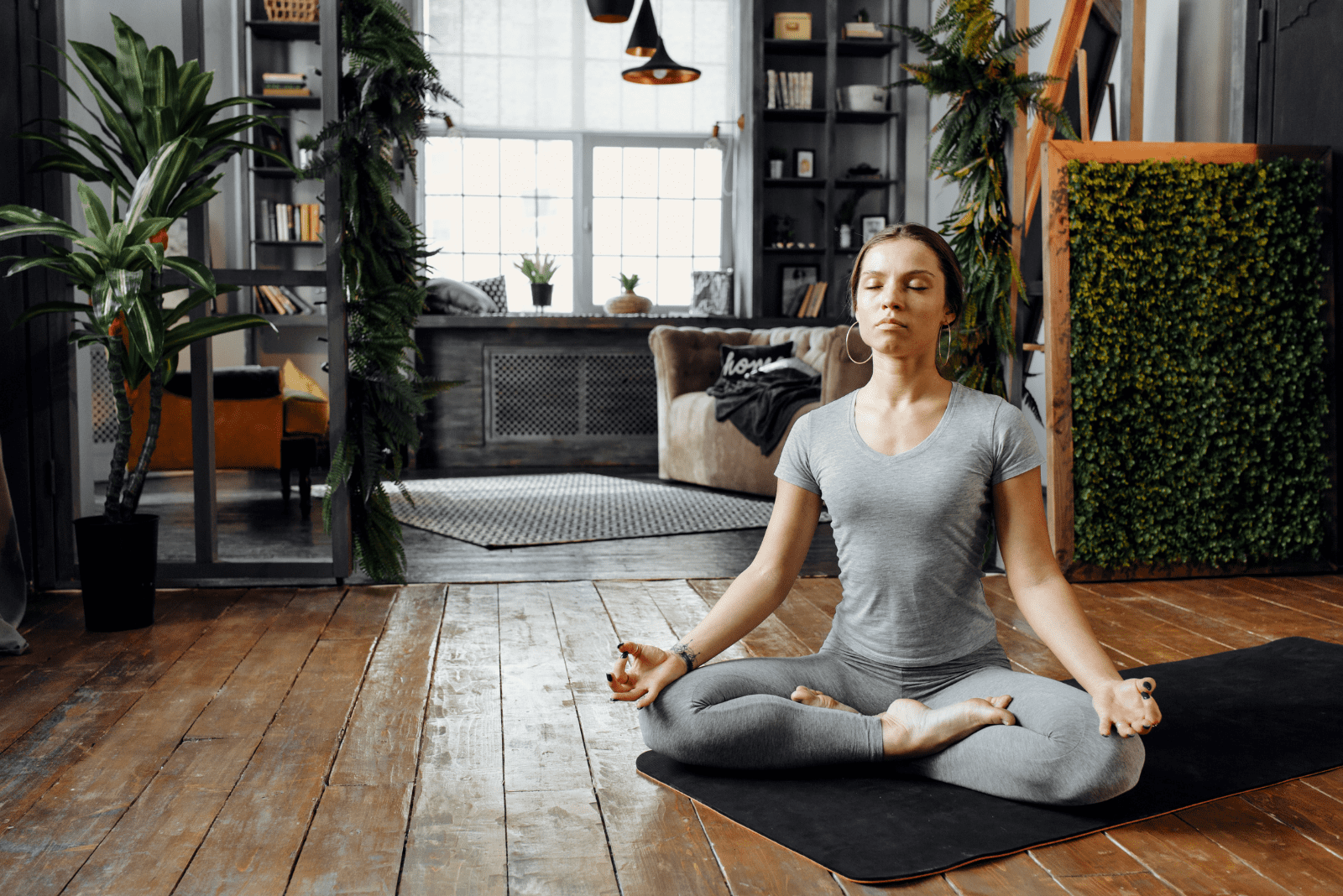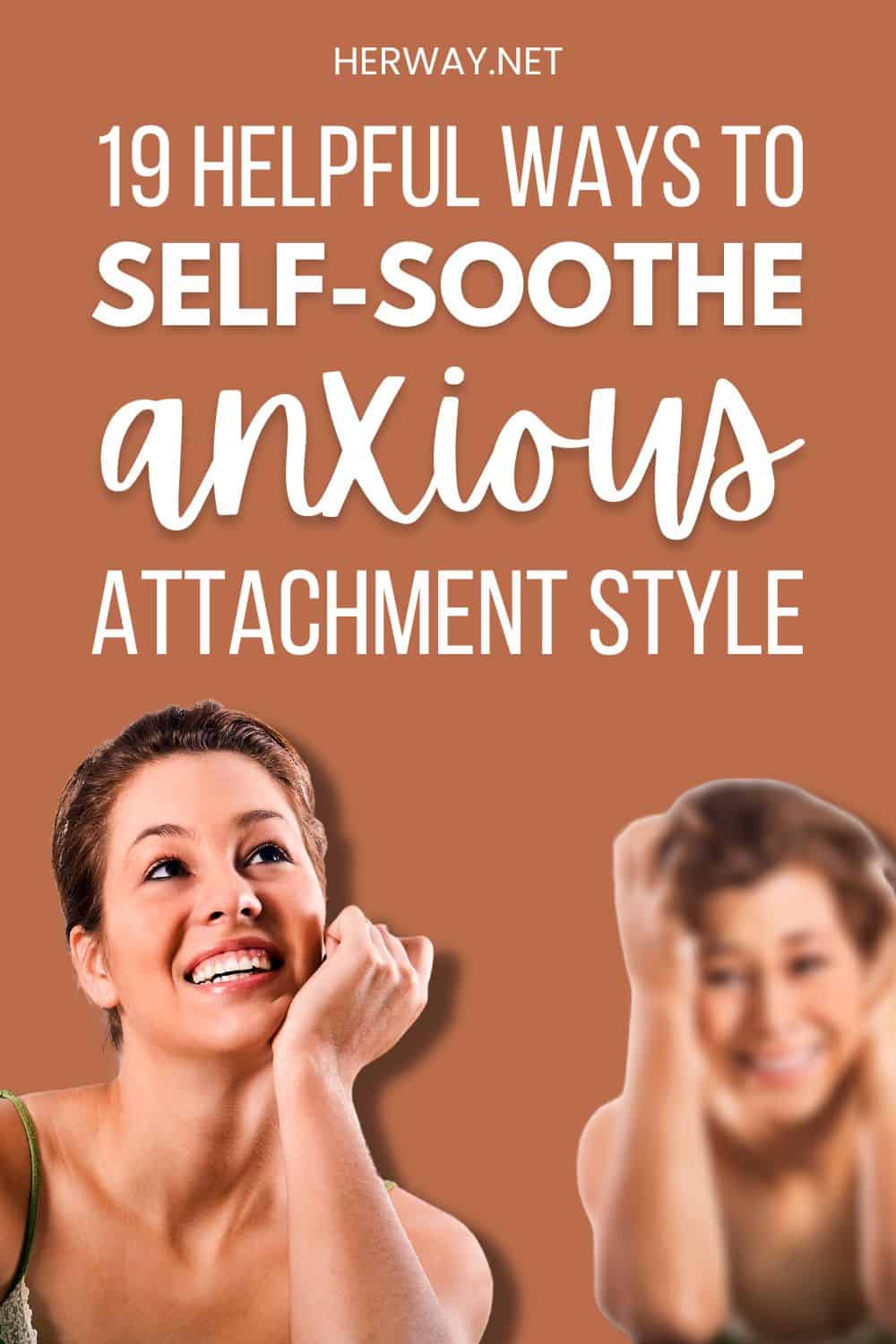We all have different attachment styles. Actually, we develop different attachment styles by engaging in different kinds of relationships.
If you’re struggling with the anxious attachment style, also known as the ambivalent attachment or anxious-preoccupied attachment style, and want to know how to self-soothe anxious attachment, stay with me because I’ll give you the best tips to self-regulate.
Once you learn to deal with your attachment style, you’ll notice how it’ll affect and improve every aspect of your life, especially the social side.
I’ve struggled with an anxious attachment style most of my life, so, trust me, I understand you completely. I’m going to share the experience of my path to recovery with you, and I truly hope it’ll serve you and help you change your attachment style from anxious to secure attachment.
How To Self-Soothe Anxious Attachment Style: 19 Tips
If you’re struggling with this ambivalent attachment style, here are the ways you can learn to self-regulate it and deal with it in a healthy way.
1. Learn to breathe properly
So many mental health and emotional issues can be controlled by proper breathing. People don’t quite believe in it, but it’s really true.
When you get anxious about something, your breathing also changes, and if you don’t control it first, your anxiety only gets bigger. If you learn to control your breathing, you’ll also manage to calm your anxiety enough to think of a way to deal with it completely.
• Wave goodbye to your anxiety and get into a relaxed state
You can also try yoga, meditation, or other activities that may help you relax. One meditation technique is mindful breathing, and you should try it ASAP.
You won’t only learn how to breathe when you have an anxiety attack, but you’ll also learn to breathe properly in general, which is highly important for your general well-being.
2. Take time for yourself
The first step to healing your anxious attachment style is accepting and admitting you have one. In order to fully accept it, you need to be alone.
You need to reflect on your past relationships. You need to organize your thoughts and emotions. And, of course, to do all of that, you need to have some alone time.
• Acceptance is the first step to pulling yourself together
Only when you accept you have this type of attachment style will you be able to deal with it. If you keep denying it, that means you’re running away from facing it, and it definitely won’t help you deal with it.
3. Think about the anxious attachment triggers
Childhood trauma may be the trigger for your attachment style. However, maybe you’ve dealt with too many avoidant partners in the past or toxic people who affected your emotional and mental health.
Perhaps the reason you have an anxious attachment style is that you were in several toxic relationships or toxic surroundings for a long period in your life, and it left consequences on your mental health.
Now, every time you engage in a romantic relationship, you think the other person will leave and break your heart.
• You can’t move on without finding the root cause
Even though I get you, and it’s true that none of it is your fault, you still need to find what triggers your attachment style and then deal with it. In other words, you can’t deal with it if you don’t know what provoked it.
When you find the root cause, you need to focus on that. Deal with it first, and that will put an end to your anxiety.
4. Engage in self-care
It’s important to shift your focus back on yourself. The reason your self-esteem got so damaged is that you don’t engage in proper self-care or you neglected yourself totally.
You’re probably a people-pleaser, and I assume you’re someone who always takes care of others, but it’s time to pay yourself some attention.
• Listen to your body, mind, soul, and heart
You need to listen to your body. If it’s saying that it’s tired, then slow down for a moment and take a rest.
If your mind is telling you that it’s overwhelmed, then you need to stop overthinking everything. Overthinking, overanalyzing, and worrying too much won’t solve anything.
Now, your soul… If your soul is showing signs of tiredness and exhaustion, if it feels neglected, then you need to drop whatever you’re doing and pay some attention to it.
And, probably the most important part: if your heart is telling you that it’s tired of being disrespected and taken for granted, you need to forget about those who made it feel that way. Find people who will love you and remind your heart that it’s worthy of love.
5. Your mental health and emotional well-being are important
We all deal with certain things and problems in life, and most of us neglect our well-being while dealing with those things. However, that is something you shouldn’t allow yourself to do no matter what.
Your emotional, physical, and mental health need to be and stay your main priority in life forever. Everything else can wait. If you notice your health is suffering, drop whatever you’re doing and focus on your well-being.
• Get rid of whatever harms your peace of mind
This will do wonders for both your mental and emotional well-being. If you’re surrounded by people who don’t see your worth or bad, toxic peeps, it’ll affect your mental health and make you feel anxious.
On the other hand, if you keep holding onto someone who continually hurts you or doesn’t want to be part of your life anymore, it’ll damage your emotional well-being. It’ll only deepen your anxious attachment, and you may never know how to maintain a healthy relationship again.
6. Pay attention to your self-esteem
It’s high time to do a self-esteem check. If you have low self-esteem, then it’s one of the triggers of your attachment style.
• Low self-esteem makes you easy prey for the insecure attachment style
And if you really struggle with self-esteem, you need to work on improving it. You can’t move on from anxious attachment if you don’t build better confidence.
7. Understand that you are worthy of love!
And whoever says different, you need to let them go out of your life. You deserve love, and you deserve to be loved in the most perfect way.
As long as you don’t understand this, you won’t be able to create a secure attachment style. Your social life will suffer the consequences.
• You just need to learn how to recognize real love and let it come into your life
The reason you think you aren’t worthy of love is that you always meet the wrong people and let them into your life and heart. You fail to read them and their real intentions for you.
8. Nurture and keep your inner child alive
We all like to hang out and spend time with small kids, right? Why is that so, you think? Well, it’s simply because children are naive, funny, and kind-hearted. They always manage to make our days better.
For that reason, you should try to keep your inner child alive. You’ll laugh more often and lead a happier and more peaceful life.
• Don’t be afraid to let your inner child out
Also, don’t be afraid to show others your inner child, and don’t ever be ashamed of it. That child in you can only carry your biggest qualities and help you a lot when it comes to your social life.
9. Find a way to calm your nervous system
When you’re dealing with stress on a daily basis, I know it’s difficult to stay calm. You get nervous, and that affects your entire well-being.
• Everything is so much easier when you decide to simply chill out
However, you need to find a way to react to stress in a more healthy way. Sometimes, you simply need to chill out and promise yourself that no matter what happens, you won’t allow it to bother you or make you feel bad and anxious.
10. Self-regulate your emotions
You own your emotions, and only you can regulate them. Don’t expect others to control your emotions because that is impossible.
• Stop repressing and start accepting
It’s completely okay to have negative emotions from time to time. However, you need to learn to deal with them in a healthy way and make them go away. Don’t ignore or bury them somewhere deep down in yourself because that will only make you codependent on your partner.
11. Make sure your emotional needs are being met
Part of a healthy relationship is both partners fulfilling each other’s emotional needs. And it’s a fact that you can’t expect the other person to meet your needs if you constantly choose to ignore theirs. However, the thing is also…
• Don’t expect others to fulfill your emotional needs if you can’t do it yourself
You have to learn to meet your own emotional needs and demands. You need to learn to listen and understand your own needs. This is actually the key to happiness and a secure attachment style.
12. Put an end to the protest behavior
Sometimes, you display protest behavior, right? You start denying that you have the anxious attachment style and don’t want to face it at all.
• Muster up the courage to face reality
It’s easy to deny and ignore things. However, it won’t make them go away. As long as you don’t completely accept your attachment style, you’ll never be able to deal with it.
13. Face your fear of abandonment
This is one of the main anxious attachment style triggers. When you have unhealthy attachment patterns in a partnership, you constantly fear that your loved one will leave you sooner or later.
Those thoughts make you anxious, and as long as you don’t deal with them properly, you won’t be able to build a secure attachment style. You need to understand that breakups are also part of life and that people will come and go from your life.
• One day, someone will come, and they’ll never let you go
It’s true that people will come and go from your life, but it’s also true that one day, someone will come, and they’ll never want to leave your life again. That’s why there is no reason for your fear of abandonment.
14. Get rid of negative thoughts
Want to know how to self-soothe anxious attachment style? Clearing your mind from negative thoughts is a number one must-do.
You think you can’t affect it, but the truth is, you’re the owner of your body, mind, and heart, not the other way around.
• Negative thoughts feed your anxiety
In fact, negative thinking is the best food for anxiety and anxious attachment style. The more you keep thinking negatively, the more anxious you’ll become. That will result in the inability to form and maintain healthy and stable partnerships.
15. Make sure you have positive thought patterns
I know this is easier said than done, but to deal with your attachment style, you need to start thinking positively.
It’s not easy to have a positive thought pattern when you’re dealing with so many fears and issues, but if you want it really hard, you’ll find a way to redirect your mind to think positively.
• Arm yourself with positive thoughts
Your anxiety won’t stand a chance if you decide to think positively from now on.
Understand that we all go through some bad things, but if you keep a positive perspective, you’ll always come out a winner.
16. Stop seeking constant reassurance and validation
I get that your low self-esteem makes you seek out constant reassurance from other people, but you need to stop for a moment and be honest with yourself… Do you really need it? Do you really have the need for low self-esteem?
First of all, stand in front of a mirror and be honest about whether the person standing in front of you deserves to wait for other people’s reassurance. Then, look around and tell me whether everything you achieved and gained to this point now doesn’t prove your worth.
Of course, it does. You just need to admit it to yourself once and for all. Stop doubting your self-worth. You are worth so much more than you think you are, and it’s high time you realize it.
• Get the validation you so desperately need from yourself
After changing the way you see yourself, now it’s time to change the way you speak to yourself. You need to validate yourself instead of seeking validation from others.
Be a friend to yourself, not an enemy. Just be realistic with yourself and give yourself a bit of encouragement through positive self-talk.
17. Surround yourself with people who honestly love you
Most of us are aware of our attachment style, but most of us also choose to keep it for ourselves, fearing that others may run away if they find it out. Unfortunately, that is so wrong.
If you’re dealing with an attachment style that doesn’t allow you to engage in a romantic relationship or harm your social life, it’s highly important to share it with someone you love and trust.
This is really one of those things you can’t deal with and go through alone. You need to have your loved ones near you, and they need to know the demons you’re dealing with.
• Your support group will help you get through this
Your loved ones will do whatever it takes to make you feel accepted and loved. They’ll also help you find ways to end your anxious patterns and build a secure attachment style.
They’re there for you, and they’ll constantly remind you of your worth and how much you actually deserve to be loved. You’ll get all the validation you (think) need from them.
18. Don’t run away from engaging in intimate relationships
An anxious person may also struggle to build an intimate connection with others. They are simply afraid of emotional closeness, so they choose to avoid those kinds of relationships rather than face their fears.
That’s probably the biggest similarity anxious people have with avoidants. However, if you want to learn how to self-soothe anxious attachment, you need to stop running from intimate relationships.
• Dealing with your fear of intimacy
First of all, try to find what triggered your fear of intimacy. Once you find the root cause, deal with it first – it’ll help you control your fear and leave it in the past.
Also, talk to your partner about it. If they honestly care about you, they’ll understand you. They’ll take things slow and wait until you show them clearly that you’re ready.
There is nothing wrong with going slow in a relationship, but avoiding intimacy will definitely harm your relationship. Sooner or later, it’ll create emotional disconnection or blockage between you and your partner.
19. If you’re in a relationship, make sure it’s a healthy one
No matter your feelings towards your partner, you should never stay in a relationship where you don’t feel respected, loved, and appreciated. Because if your SO doesn’t make you feel that way, it’s more than obvious they don’t love you.
When you engage in a romantic relationship, put effort into making it work and building healthy foundations for it. If you constantly fail to make your relationship a healthy one, then you need to know when it is the time to end it because it’s a sign that you and that person aren’t meant to be.
• Love yourself first and foremost
Don’t waste your time on the impossible. Don’t ever allow anyone to make you feel unworthy of love or to make you doubt your self-worth.
You need to love yourself and always know who you are in life. The moment you notice unhealthy patterns in your relationship, you need to either deal with them instantly or give up on that relationship.
What Triggers Anxious Attachment?
In the 1950s, psychologists John Bowlby and Mary Ainsworth built the revolutionary attachment theory. They did their research and concluded that every person develops an attachment style in early childhood, which affects their adult relationships later on.
Meaning, every attachment style is triggered by early childhood events. If someone was emotionally neglected or abused by their parents, they’ll probably form an anxious attachment style.
Also, dealing with avoidant and toxic partners may be a trigger for developing the anxious attachment style. Low self-esteem and doubting your self-worth can also cause this type of attachment.
If you don’t feel good in your own skin and don’t have a good self-opinion, you’ll constantly seek validation from others.
That need for reassurance will make you engage in a codependent relationship, which means you won’t be able to build and maintain a healthy relationship with another human being.
Other triggers for this attachment style may be someone having unrealistic expectations and being codependent on another person. That constant fear of being left alone or disappointed may be a cause for attachment anxiety.
What Are Signs Of Anxious Attachment?
There are so many signs of an anxious attachment style, and most of them are pretty clear and clearly show the anxious attachment patterns in a person. However, the most obvious ones are clinginess, codependency, and the need for constant reassurance and validation.
The biggest difference between the anxious and avoidant attachment styles is that the avoidant person runs from emotional connection and is afraid to engage in a serious, healthy relationship. On the other hand, anxious people are afraid of a breakup because of their fear of being left alone.
An anxious person is almost always codependent on their romantic partner because of their low self-esteem and because they need them for constant validation.
Also, someone with anxious attachment has self-worth issues and feels unworthy of love. They’ll tolerate toxic and unhealthy behavior from their partner because they think they deserve it but also because of their fear of abandonment.
They’re constantly in search of a romantic partner because they can’t function alone (at least, that’s what they think), unlike fearful avoidants who run away from love because they’re afraid to be hurt.
What Does Anxious Attachment Feel Like?
You feel unworthy of love and everything good and positive. When you find that one person who loves and accepts you, you stick to them no matter what because you think you’ll never find another person who’ll love you again.
You become codependent on your loved one, and you’re basically ready to do whatever it takes just to keep them by your side. Losing them becomes your biggest fear, and that thought makes you anxious 24/7.
Every time you notice a potential danger in your relationship, strong emotions overwhelm you, and your low self-esteem makes you believe that your partner is going to break up with you.
You start thinking that everything you do is bad, and you need your partner to constantly remind you that is not true. Also, your confidence crashes completely, and getting positive feedback from your partner means everything to you. That’s why you never stop seeking validation from them.
Anxious attachment style feels like everyone else is better than you. Your own thoughts are killing you, but it seems like you can’t find a way to run away from them. Anxious attachment makes your day-to-day life miserable, and until you decide to break that cycle, you’ll never be truly happy.
In Conclusion
So, did you figure out how to self-soothe anxious attachment style? Do you understand this attachment style better now?
I hope you did, and I hope my tips will help you build a secure attachment style.
Even though most people think that attachment styles are connected with attachments someone makes in early childhood and with their primary caregivers and can’t be changed later in life, it’s not true.
It’s connected with our childhood, but by working on yourself, you can change your attachment style. I know so many people who have moved on from anxious, anxious-avoidant, or avoidant attachment style and built a secure attachment style.
Well, I have a little confession to make… I belong to that group of people too. I rewired my brain, and today, I’m proud to say I have a secure attachment style. And trust me, if you follow these tips carefully, you’ll be able to build this style too.








